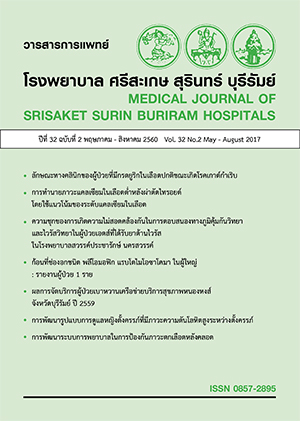ความชุกของการเกิดความไม่สอดคล้องกันในการตอบสนองทางภูมิคุ้มกันวิทยาและไวรัสวิทยาในผู้ป่วยเอดส์ที่ได้รับยาต้านไวรัส ในโรงพยาบาลสวรรค์ประชารักษ์ นครสวรรค์
Main Article Content
บทคัดย่อ
หลักการและเหตุผล: ผู้ป่วยที่ได้รับยาต้านไวรัสเอชไอวีโดยทั่วไปจะทำให้เชื้อเอชไอวีในเลือดลดลง
และทำให้เซลล์ซีดีสี่เพิ่มขึ้น แต่มีผู้ป่วยบางคนที่ได้รับยาต้านไวรัสแล้วมีการ ตอบสนองแบบไม่สอดคล้องกัน โดยมีปริมาณไวรัสในกระแสเลือดลดต่ำลง กว่าระดับที่สามารถตรวจวัดได้ แต่ปริมาณเซลล์ซีดีสี่ไม่เพิ่มขึ้น ขณะที่ผู้ป่วย บางคนมีการตอบสนองแบบอื่น คือมีเซลล์ซีดีสี่เพิ่มขึ้นทั้งๆ ที่มีไวรัสจำนวนมากในกระแสเลือด
วัตถุประสงค์: เพื่อศึกษาความชุกของการเกิดความไม่สอดคล้องกันในการตอบสนองทาง
ภูมิคุ้มกันวิทยาและไวรัสวิทยาในผู้ป่วยเอดส์ที่ได้รับยาต้านไวรัส
สถานที่ศึกษา: เอชไอวีคลินิก กลุ่มงานอายุรกรรมโรงพยาบาลสวรรค์ประชารักษ์นครสวรรค์
รูปแบบศึกษา: ศึกษาเชิงพรรณนาย้อนหลัง
วิธีการศึกษา: รวบรวมข้อมูลย้อนหลังจากเวชระเบียนผู้ป่วยนอกที่ติดเชื้อเอชไอวีระหว่าง
วันที่ 1 มกราคม-ธันวาคม 2558 ทำการวิเคราะห์โดยกำหนดเกณฑ์การ ตอบสนองดังนี้ คือมีการตอบสนองทางภูมิคุ้มกันถ้าจำนวนซีดีสี่ในเลือด มากกว่า 350 เซลล์ต่อไมโครลิตรและการมีไวรัสถูกกดเมื่อเชื้อไวรัสเอชไอวี มีปริมาณน้อยกว่า 50 คู่ต่อมิลลิลิตรหรืออยู่ในระดับน้อยกว่าการตรวจสอบ ได้ ภายหลังจากให้ยาไปแล้ว 6 เดือน ข้อมูลจะถูกนำเสนอออกมาเป็น 3 กลุ่มของการตอบสนองทางภูมิคุ้มกันวิทยาและไวรัสวิทยา ดังนี้กลุ่มการตอบสนอง แบบสอดคล้อง, กลุ่มการไม่ตอบสนองแบบสอดคล้อง และกลุ่มการตอบสนอง แบบไม่สอดคล้องกันโดยนำเสนอในรูปจำนวนความถี่และจำนวนเปอร์เซ็นต์
ผลการศึกษา: จำนวนผู้ป่วยเอดส์ทั้งหมด 3,933 คน เป็นเพศชาย 2,096 คน พบการตอบ สนองทางภูมิคุ้มกันวิทยาและไวรัสวิทยาแบบสอดคล้องโดยรวม ร้อยละ 73.7 แบบไม่สอดคล้อง ร้อยละ 26.3 โดยแยกเป็นการตอบสนองเฉพาะทางไวรัส อย่างเดียว ร้อยละ 24 และเฉพาะทางภูมิคุ้มกันวิทยาอย่างเดียว ร้อยละ 2.3 เปอร์เซ็นต์การตอบสนองแบบไม่สอดคล้องนี้พบในผู้ชายร้อยละ 32.1 สูงกว่า ผู้หญิงร้อยละ 19.5
สรุป: จากการศึกษาที่โรงพยาบาลสวรรค์ประชารักษ์พบว่าผู้ป่วยเอดส์ภายหลังการรักษาด้วยยาต้านไวรัสเอชไอวีเป็นเวลา 6 เดือนมีความชุกของการตอบสนอง แบบไม่สอดคล้องกันทางภูมิคุ้มกันวิทยาและไวรัสวิทยาเท่ากับร้อยละ 26.3 โดยความไม่สอดคล้องกันนี้พบได้ในผู้ป่วยชายมากกว่าผู้ป่วยหญิง
Article Details
เอกสารอ้างอิง
2. สำนักงานหลักประกันสุขภาพแห่งซาติ. สถานการณ์เอชไอวีและเอดส์ประเทศไทย พ.ศ. 2559. รายงานวันเอดส์โลก 2559:3.
3. May MT, Ingle SM, Costagliola D, Justice AC, de Wolf F, Cavassini M. Life expectancy of individuals on combination antiretroviral therapy in high- income countries: a collaborative analysis of 14 cohort studies. Lancet 2008; 48:293-9.
4. The Antiretroviral Therapy (ART) Cohort Collaboration. The Antiretroviral Therapy (ART) Cohort Collaboration. Prognosis of HIV-1 infects patients up to 5 years after initiation of HAART: collaborative analysis of prospective studies. AIDS 2007;21:1185-97.
5. Kumar RS. Immunovirological discordance in HIV. Medicine update 2012;22:89-93.
6. ศักดิ์ชัย เดชตรัยรัตน์. Discordant responses in patients being treated in Chiang-mai. รายงานการประชุมวิชาการเอดส์และโฟไซโทรเมทรี ประจำปี พ.ศ.2551;14:11.
7. Nicastri E, Chiesi A, Angeletti c, Sarma-ti I, Palmisano L, Geraci A, et al. Clinical outcome after 4 year follow-up of HIV-sero positive subjects with incomplete virologic or immunologic response to HAART. J Med Virol 2005; 76:153-60.
8. Renaud M, Katlama C, Mallet A, Calvez V, Carcelan G, Tubiana R, et al. Determinants of paradoxical CD4 cell reconstitution after protease inhibitor-containing antiretroviral regimen. AIDS. 1999;13:669-76.
9. Moore DM, Hogg RS, Yip B, Wood E, Tyndall M, Braitstein p, et al. Discordant immunologic and virologic responses to highly active antiretroviral therapy are associated with increased mortality and poor adherence to therapy. J Acquir Immune Defic Syndr 2005;40:441-6.
10. Tan R, Westfall AO,Willig JH, Mugave-ro MJ, Saag MS, Kaslow RA, et al. Clinical outcome of HIV-infected antiretroviral-naive patients with discordant immunologic and virologic responses to highly active antiretroviral therapy. J Acquir Immune Defic Syndr.2008;47:553-8.
11. Piketty C, Castiel P, Belec L, Batisse D, Mohamed AS, Gilquin J, et al. Discrepant responses to triple combination antiretroviral therapy in advanced HIV disease. AIDS. 1998;12:745-50.
12. Grabar S, Le Moing V, Goujard c, Leport c, Kazatchkine MD, Castagliola D, et al. Clinical outcome of patients with HIV-1 infection according to immunologic and virologic response after 6 months of highly active antiretroviral therapy. Ann Intern Med. 2000;133:401-10.
13. Tuboi SH, Brinkhof MWG, Egger M, Stone RA, Braitstein p, Nash D, et al. Discordant responses to potent antiretroviral treatment in previously naive HIV-1 infected adults initiating treatment in resource-contrained countries. The antiretroviral therapy in low-income countries (ART-LINC) collaboration J Acquir Immune Defic Syndr. 2007;45:52-9.
14. Gutierrez F, Padilla S, Masia M, Iribarren JA, Moreno S, Viciana p, et al. Patients characteristics and clinical implications of suboptimal CD4 T-cell gains after 1 year of successful antiretroviral therapy. Curr HIV Res 2008;6:100-7.
15. Florence E, Lundgren J, Dreezen c, Fisher M, Kirk o, Blaxhult A, et al. Factors associated with a reduced CD4 lymphocyte count response to HAART despite full viral suppression in the Euro SIDA study. HIV Med. 2003;4:255-62.
16. Barreiro PM, Dona MC, Castilla J, Soriano V. Patterns of response(CD4 cell count and viral load) at 6 months in HIV infect patients on highly active antiretroviral therapy. AIDS. 1999;13:525-6.
17. Gilson R, Man S-L, Copas A, Rider A, Forsyth S, Hill T, et al. Discordant response on stating highly active antiretroviral therapy: suboptimal CD4 increase despite early viral suppression in the UK Collaborative HIV Cohort (UK CHIC) study. HIV Med 2010;11:152-60.
18. Piketty C, Weiss L, Thomas F, Mohamed AS, Belec L, Kazatchkines MD. Longterm clinical outcome of human immunodeficiency virus-infected patients with discordant immunologic and viralogic response to a protease inhibitor containing regimen. J infects Dis. 2001;183:25.
19. Nicastri E, Angeletti C, Palmisano L, Sarmati, Chiesi A, Geraci A, et al. Gender differences in clinical progression of HIV-1 infected individuals during long term highly active antiretroviral therapy. AIDS. 2005;19:577-83.
20. Falster K, Petoumenos K, Chuah J, Mijch A, Mullhall B, Kelly M, et al. Poor baseline immune function predicts an incomplete immune response to combination antiretroviral treatment despite sustained viral suppression. J Acquir Immune defic Syndr.2009;50:307-13.
21. Kelley CF, Kitchen CMR, Hunt PW, Rodriguez B, Hecht FM, Kitahata M, et al. Incomplete peripheral CD4+ cell count restoration in HIV-infected patients receiving long term antiretroviral therapy .Clin Infect Dis. 2008;47:1093-101.
22. PCL Hospitality Co., Ltd. CD4 counts by Flow cytometry FC 500 Beckman Coulter Inc CA 92821 (Monograph on the Internet). USA; 2004 [Cited 2016 May 15]. Available form: https://www. rpciflow.org/pdfs/manuals/fc500/ FC500%20lnstruction%20Manual.pdf.
23. Abbott Laboratories Ltd. Abbott Real Time HIV-1. Abbott Molecular Inc. IL 60018 (Monograph on the Internet). USA; 2012 [Cited 2016 June 10], Available form:https://www.molecular. abbott/sal/en-us/staticAssets/ realtime-hiv-l-package-insert.pdf.
24. Grabar S, Lousignian I, Sobel A, Le Bras P, Gasmault J, Enel P, et al. Immunologic and clinical responses to highly active antiretroviral therapy over 50 years of age. Results from the French Hospital Database on HIV. AIDS: 2004;18:2029-2038.
25. Sachdeva N, Asthania V, Brewer Th, Garcia D, Asthana D, Impaired restoration of plasmacytoid dendritic cells in HIV-1 infected patients with poor CD4 T cell reconstitution is associated with decrease in capacity to produce IFN-alpha but not proinflammatory cytokines, J Immunol 2008:181:2887-97.
26. Khanna N, Opravil M, Furrer H, Cavassini M, Vernazza P, Bernaconi E, et al. CD4+ T cell count recovery in HIV type 1- infected patients is independent of class of antiretroviral therapy. Clin Infect Dis 2008;47:1093101.
27. Levy Y, Lacabaratz C, Weiss L, Viard JD, Goujard C, Levievre JD, et al. Enhanced T cell recovery in HIV-1 infected adults through IL-7 treatment. J Clin Invest 2009;119:9971007.
28. Douek DC, McFarland RD, Keiser PH, Gage EA, Messey JM, Haynes BF, et al. Changes in thymic function with age and during the treatment of HIV infection. Nature 1998;396(6712): 690-695.


